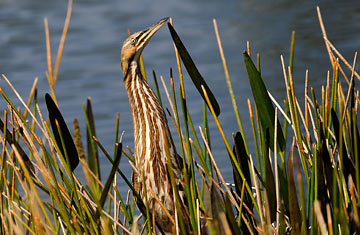
An American bittern hides in the marsh in Naples, Fla.
Big, bad carbon dioxide gets most of the attention when it comes to greenhouse gases, but it's not the only one that's warming the earth. Methane — a gas that is found in everything from landfills to cow stomachs — also plays a big role. Although global methane-emissions levels are much lower than CO2 emissions, pound for pound methane is a more powerful greenhouse gas; a ton of it has 23 times the warming effect of a ton of CO2. And methane, like CO2, is on the rise thanks to us: about 60% of global methane emissions come from man-made sources, and the atmospheric concentration of methane has increased by around 150% since 1750, according to the Intergovernmental Panel on Climate Change. Now there's new focus on a pair of methane sources that we usually don't think of as natural polluters: wetlands and rice paddies.
Separating the factors that contribute to climate change from the things that help reverse it is not always easy because sometimes they're one and the same. Trees sop up CO2, for example, but when they die and decay they release it back into the air. Wetlands and rice paddies serve a similarly dual role for both CO2 and methane, acting as sources and sinks simultaneously. The challenge has been trying to tease out how those two functions balance out, but a new paper in the Jan. 14 issue of Science has provided some hard numbers. Using satellite data, investigators determined that wetlands contribute from 53% to 58% of global methane emissions and that rice paddies are responsible for more than a quarter of that output. The study could help make climate-change models more accurate, and help scientists understand whether increasing temperatures will lead to even higher methane emissions down the road. "It's all about more accurately describing climate in these models," says Paul Palmer, a geoscientist at the University of Edinburgh and a co-author of the Science paper.
The warm, waterlogged soil of wetlands is prime habitat for the anaerobic microbes that produce methane — and in general, the warmer and wetter, the more the methane. Since rice paddies are kept underwater during the wet growing season in Southeast Asia and other major rice producing areas, paddies too serve as ideal factories for methane. "[The farmers] use controlled floods, and that's guaranteed to produce methane," says Palmer.
The data Palmer and his colleagues used came from the Envisat satellite, launched by the European Space Agency, which gave them a rough picture of methane concentrations across the entire atmosphere. They then combined that with measurements from the multinational Gravity Recovery and Climate Experiment (GRACE) satellite, which gave them a broad estimate of planet-wide groundwater levels. Finally they added surface-temperature data from the U.S. National Center for Environmental Prediction/National CENTER for Atmospheric Research, because heat can increase methane emissions from wetlands as well.
This not only yielded the raw numbers on the amount of methane being produced, but also some information about emission trends. There has been a steady increase in wetlands methane emissions from 2003 and 2007 — and most of that increase was due to wetlands in the temperate regions north or south of the tropics. Moreover, emissions from Arctic wetlands — they do exist — were increasing fastest of all, up more than 30% between 2003 and 2007. That could be due to overall warming. "Most climate models say the surface is going to warm at higher latitude, and this is going to have serious implications for emissions from wetlands," says Palmer.
Indeed, many scientists worry that we could reach a tipping point at which warming could begin to melt the Arctic permafrost and unleash masses of buried methane — which would then further warm the atmosphere, releasing more methane and continuing in a dangerous feedback cycle. But if we're going to prevent that from happening, we're going to have to find a way other than reducing methane emissions from wetlands. Global food requirements mean that we can't cut back seriously on rice paddy cultivation, and wetlands are far too important to the environment as groundwater filters and buffers against coastal floods. "I just don't see any way to control methane emissions from wetlands," says Palmer. Instead, we'll need to focus on methane emissions from man-made sources — like landfills or natural gas drilling — and cut what is still greenhouse gas No. 1: CO2.
